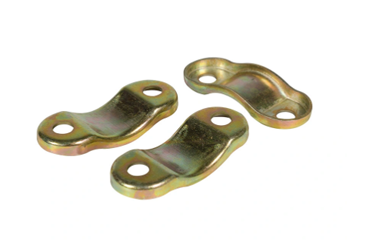
Precision metal stamping is among the most common metalworking techniques utilized by various industries to turn sheet metal into custom parts.
Progressive metal stamping uses tooling called a progressive die, which contains multiple stamping stations to perform simultaneous operations on a sheet metal strip. A feeding system unrolls the strip from its coil and guides it through each of the die's workstations until the final part is produced.
Given the range of materials and techniques involved in this process, it's crucial to understand the available options and key factors to consider before beginning.
Manufacturers utilize various metals in precision metal stamping, but some metals and processes are better suited for this application or specific use cases.
Hot rolled steel is roll-pressed at high temperatures and then rapidly cooled, resulting in a rough surface finish. When applications require tighter dimensional tolerances and higher accuracy, the metal undergoes additional processing at room temperature through cold finishing techniques.
During cold rolling, mechanical stress alters the crystalline structure of the metal, resulting in increased strength and often enhanced corrosion resistance. Cold-rolled stainless steel coils can be precision-manufactured to extremely tight tolerances. Precision stamping involves forming metal using stamping dies, typically at room temperature, making it a cold process.
Compared to hot rolled steel, cold-rolled steel offers several key advantages that make it ideal for the increasing demands of precision metal stamping:
- Smooth, finished surfaces
- Precise edges and flatness
- Consistent dimensional uniformity (width and thickness)
- Enhanced strength and hardness
- Uniform and predictable material properties
When selecting a metal, it's important to weigh the benefits and limitations of each material against the specific requirements of your part.
For instance, aluminum is lighter and softer than stainless steel and serves as a good conductor of electricity. However, stainless steel can withstand much higher temperatures and more corrosive environments.
Titanium, in contrast, is both lightweight and significantly stronger and more durable than aluminum. This makes it ideal for aerospace, military, and defense applications where a high strength-to-weight ratio is crucial. Additionally, titanium is corrosion-resistant and biocompatible, making it suitable for medical implants.
Ultimately, the key is to match the alloy and its properties with the specific demands of the application.
When selecting a material for precision metal stamping, several key factors should be taken into account, including the metal’s ductility and formability, tensile strength, machinability, and work hardening rate.
Forming occurs between the yield strength and tensile strength of the material. If the yield strength is not exceeded, forming does not occur, but exceeding the tensile strength results in material fracture. For higher-strength materials, the window between yield and tensile strength is narrow.
Grain size is a common indicator of a material's formability, with consistent grain size being highly desirable for forming operations. Grain size can be controlled within a very close range by monitoring the temperature of the annealing furnace and the speed at which the strip passes through the rerolling mill.
Tensile strength measures the force a material can withstand without breaking. The strength of a metal varies depending on its composition and the alloying elements it contains. It's important to consider the tensile strength of the metal to ensure it can handle the forces applied during its intended use.
Machinability refers to how easily a material can be cut or shaped. While properties that enhance a material's performance often reduce its machinability, it is still essential to consider this factor after meeting other critical requirements for your stamped stainless steel part. A machinable material can be cut quickly with a smooth finish, reducing costs. However, the primary focus should be on selecting a material that meets the specific needs of the part rather than solely on its machinability.
Work hardening occurs as metal is worked or stamped, causing it to become harder and more brittle. The rate at which this happens is known as the work hardening rate. Depending on the extent of deformation required in a particular operation, the material may need to undergo annealing to restore its properties and prevent cracking, fractures, or other imperfections.
In precision metal stamping, manufacturers employ metal forming operations to produce parts from metal and metal alloys. This process is highly versatile, enabling the creation of complex and detailed components with exceptional accuracy and repeatability. Additionally, deep-drawn parts exhibit remarkable strength due to the intense compression applied to the metal during forming. This process often results in a highly compressed and hardened crystalline structure within the metal, enhancing its overall strength and durability.
Copyright:@2020-2021
Comments Please sign in or sign up to post.
0
0 of 500 characters used